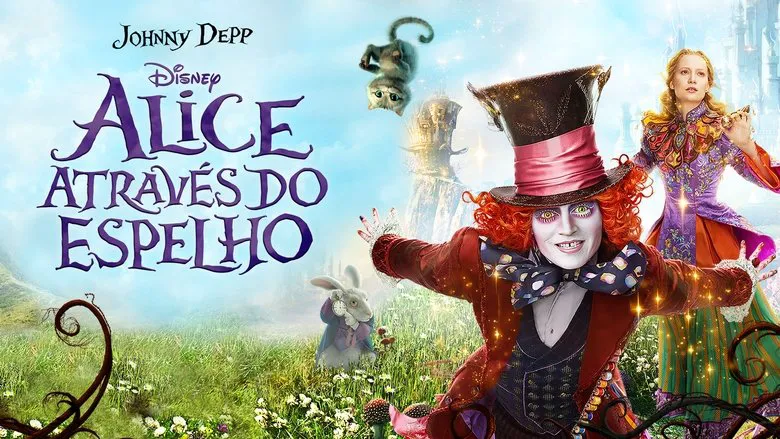Alice Through the Looking Glass: A Sequel That Stumbles
The much-anticipated sequel, “Alice Through the Looking Glass,” attempts to recapture the magic of its predecessor but unfortunately falls short, becoming more entangled in childhood squabbles than delivering the grand, fantastical adventures one would expect.
Alice Kingsleigh (Mia Wasikowska), after a three-year expedition to China, returns to London to find her family’s trading company shares sold off by her mother. This precarious situation threatens Alice’s beloved ship and her captaincy. However, these familial woes are quickly overshadowed when Alice travels through a mirror, once again finding herself in the whimsical world of Underland. A somber discovery awaits her: the Mad Hatter (Johnny Depp) suffers from a severe depression, teetering on the brink of despair. The only remedy, it seems, is to resurrect his lost family. Driven by loyalty, Alice embarks on a daring mission to persuade Time (Sacha Baron Cohen) to allow her to journey into the past and rescue the Hatter’s family from the clutches of the Jabberwocky. When Time refuses her plea, Alice impulsively steals the Chronosphere, a powerful device that controls time itself, and plunges headfirst into the depths of the past.
A Change in Direction Behind the Camera
James Bobin, known for his work on “The Muppets” and his previous collaborations with Sacha Baron Cohen (“Ali G,” “Borat,” and “Bruno”), takes over the directorial reins for “Alice Through the Looking Glass.” This change in leadership promises a different flavor, albeit with familiar comedic elements.
In the Shadow of the Original Vision
The legacy of Tim Burton’s “Alice in Wonderland,” released in 2010, looms large over this sequel. The original film, a cinematic spectacle that grossed over a billion dollars, became a commercial triumph for Disney, although it met with considerable indifference from critics. Burton’s “Alice,” written by Linda Woolverton also the writer for “Beauty and the Beast”, received mixed reviews and some found elements wanting.
Perhaps the most debated aspect of Burton’s “Alice” was the fundamental reimagining of the titular character. Woolverton, aiming to infuse the story with “feminist expertise,” seemingly transformed Alice into a symbol that clashed with the themes found in Lewis Carrolls original tale.
A Diminished Protagonist
Instead Woolverton, weakened Alice, turning her into a pawn of fate and duty. Miss Kingsleigh doesn’t reject the absurd laws of the magical world; instead, she meticulously follows them, becoming a “errand-runner” for the White Queen and her allies. While this may be a noble cause, Carroll’s original story was about something entirely different, and his young heroine was far more radical, despite not uttering feminist slogans or wielding a sword.
Lost in Potential
A three-year voyage around the globe as a ship captain should have transformed Alice into someone who doesn’t seek to please everyone.Ideally, after such a perilous adventure in a male-dominated world, her reaction to the Hatter’s depression would be something along the lines of: “Stop whining! You’re a grown man! My father died too, but you don’t see me complaining! Let’s drink some rum for our dads and sing a pirate song, then you can sew me five colorful hats. I’m sailing to Russia soon, and you’ll be distracted from your moping and get some work done!”
However, a heroine in a 21st-century Hollywood film cannot show such disrespect for the feelings of a man with painted nails. Therefore, Alice abandons her captaincy and once again becomes a warrior on a quest, traveling into the past, even though she’s committing a crime and risking the fabric of space-time. The Chronosphere powers the universal clock and ensures Time’s eternal life, so stealing it endangers the entire universe. But her desire to please a friend outweighs common sense, even though a ship captain should be able to assess risks.
A Disappointing Time-Traveling Journey
The novelty of “Alice Through the Looking Glass” begins and ends when Alice enters Time’s spectacular castle and meets the Chronosphere’s owner and his clockwork servants. After that, the heroine’s adventures are reduced to visiting the pasts of familiar characters. We learn why the Red Queen has a giant head, why the capricious villain hates the Hatter, what childhood feud divided the Red and White Queens, and how Time cursed the Hatter.
The creators expend a substantial $170 million budget offering viewers childish squabbles and clumsy falls in the past. This choice leaves you to decide if you care about the childhood squabbles. Ultimately it makes you ask, Does one cookie really matter?
When the climax arrives, Alice’s final quest boils down to running from point A to point B within time C, with no one hindering her. On the contrary, everyone helps her with all their might. At least in the first film, the heroine had to slay a fearsome dragon. Didn’t Woolverton learn that the obstacles in the heroes’ path should become higher and more insurmountable with each installment?
Final Musings
While nearly all the characters from the first movie return in this sequel, “Alice Through the Looking Glass” retains the artistic visual explosions from its predecessor while adding elements of charisma and humor contributed by Sacha Baron Cohen. However, most might find a struggle reconciling between child and adult desires while the original whimsical elements are dimmed.